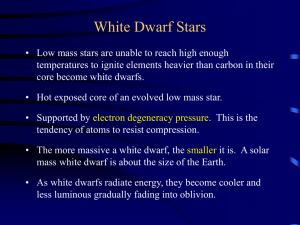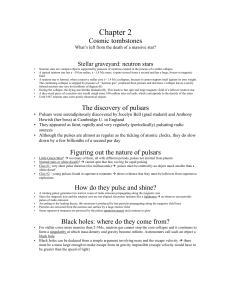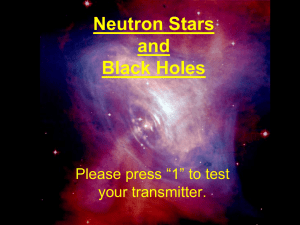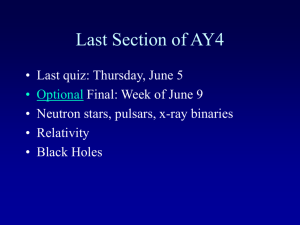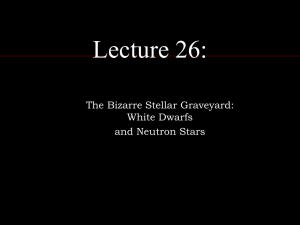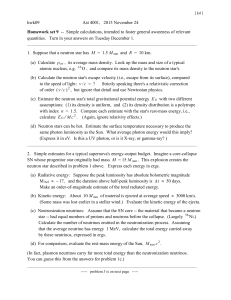Neutron Stars, Pulsars, and Black Holes
advertisement
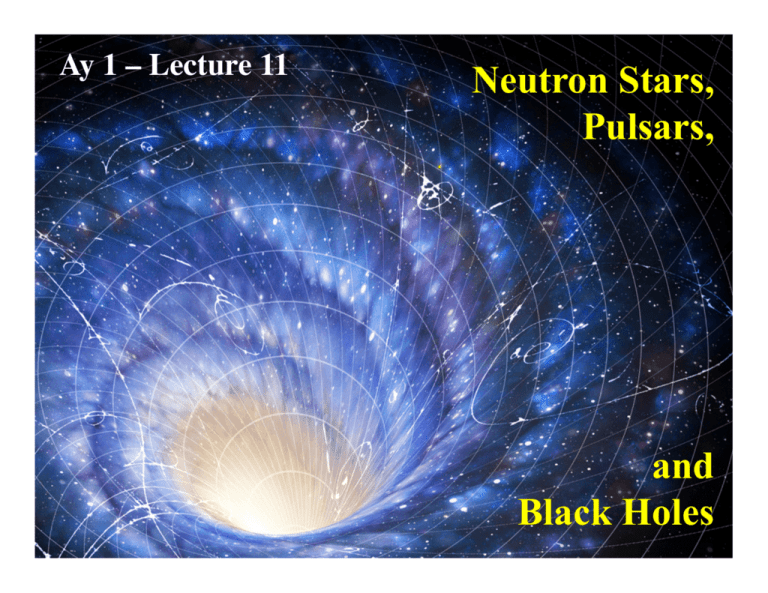
Ay 1 – Lecture 11 Neutron Stars, Pulsars, and Black Holes 11.1 Neutron Stars and Pulsars Crab nebula in X-rays, Chandra The Origin of Neutron Stars Always in SN explosions • • If the collapsing core is more massive than the Chandrasekhar limit (~1.4 M¤), it cannot become a white dwarf • Atomic nuclei are dissociated by γ-rays, protons and electrons combine to become neutrons: − e + p → n + νe • The collapsing core is then a contracting ball of neutrons, becoming a neutron star • A neutron star is supported by a degeneracy € pressure of neutrons, instead of electrons like in a white dwarf • Its density is like that of an atomic nucleus, ρ ~ 1015 g cm–3, and the radius is ~ 10 km The Structure of Neutron Stars Not quite one gigantic atomic nucleus, but sort of a macroscopic quantum object A neutron star consists of a neutron superfluid, superconducting core surrounded by a superfluid mantle and a thin, brittle crust Prediction and Discovery of Neutron Stars • The neutron was discovered in 1932. Already in 1934 Walter Baade and Fritz Zwicky suggested that supernovae involve a collapse of a massive star, resulting in a neutron star • In 1967 Jocelyn Bell and Antony Hewish discovered pulsars in the radio (Hewish shared a Nobel prize in 1974) • Fast periods (~ tens of ms) and narrow pulses (~ ms) implied the sizes of the sources of less than a few hundred km (since R < c Δt). That excluded white dwarfs as sources Pulsar: Cosmic Lighthouses • As a stellar core collapses, in conserves its angular momentum. This gives the pulsar their rapid spin • Magnetic field is also retained and compressed, accelerating electrons, which emit synchrotron radiation • Magnetic poles need not be aligned with the rotation axis. Thus, the beams of radiation sweep around as a lighthouse beam Visible The Crab Pulsar X-ray Light Curve of the Crab Pulsar Visible light, folded by the period The same behavior from radio to γ-rays Pulsar Timing and Slowdown • Because of their huge moments of inertia, most pulsars are extremely stable, as steady as (or better than) atomic clocks • However, the energy they radiate comes at the expense of the rotational kinetic energy, resulting in a gradual slowdown Erot = ½ I ω2 = 2 π2 I P –2 . L = dE/dt = 4 π2 I P –3P (I = moment of inertia, P = period) Period derivative Sudden speedups of the pulse rate (glitches) may be caused by starquakes – settling of the star to a lower moment of inertia Binary Pulsars • First one discovered in 1974 by Joseph Taylor & Russell Hulse • This is a relativistic binary, and some of the orbital kinetic energy is being radiated away as gravitational waves • The observed rate of energy loss is exactly what the General Relativity predicts! • Won the Nobel Prize in 1993 X-Ray Bursters and Millisecond Pulsars Neutron stars can be in accreting binaries Such systems become X-ray bursters The accretion of the disk material also increases the angular momentum of the neutron stars, and it can spin it up to ~ ms periods This is the origin of millisecond pulsars 11.2 Stellar Black Holes Einstein’s General Relativity (1915) • Following the special relativity, an even more fundamental change in our understanding of the physical space and time, and matter/energy • Postulates equivalence among all frames of reference (including accelerated ones) • Introduces curvature of space, predicting a number of new effects: – Light deflection by masses – Gravitational redshift etc. etc. Presence of mass/energy determines the geometry of space Geometry of space determines the motion of mass/energy Confirmation of the GR Eddington’s 1919 Solar eclipse observations “confirmed” Einstein’s relativistic prediction of α = 1.78 arcsec (confirmed by more accurate observations later) Escape Velocity An object with a mass m can escape from the gravitational potential well of a mass M from a radius R if: Ekin > |Epot| m V2 / 2 > G m M / R V > Vesc = [2 G M / R]1/2 For the Earth, Vesc = 11.2 km/s You can increase Vesc either by increasing the mass within a given radius, or by decreasing the radius for a given mass When Vesc > c, not even light can escape. The enclosed region becomes a black hole The Structure of a Black Hole • In principle, the entire mass of a black hole is concentrated in an infinitely dense singularity • The singularity is surrounded by a RS surface called the event horizon, where the escape speed equals the speed of light • For a non-rotating BH, the radius of the event horizon is the Schwarzschild radius: RS = 2GM/c2 (For our Sun, RS = 3 km, for the Earth, RS = 9 mm) • Things are a bit more complicated for a rotating BH • The only things we can know about a BH are its mass, spin, and electric charge, regardless of what was the material from which it was made At the black hole boundary (the event horizon), the gravitational force is infinite, and the time stops Forming a Stellar Black Hole • If the core of a star collapses and it has more than 3 solar masses, no known force can stop the collapse. • The electron degeneracy cannot stop the gravitational force • The neutron degeneracy cannot stop the gravitational force of collapse • The star collapses to a radius of “zero” • Now the star has infinite density and gravity—called a Singularity • We call the region where the contracting core of a star becomes small enough that the escape velocity is so large that even light cannot escape a black hole Evidence for Black Holes • A black hole alone is totally invisible • But a matter is falling into the potential well of a BH would radiate away its binding energy, e.g., in X-rays • So we can search for black holes by searching among X-ray binaries (example: Cygnus X-1) • If the object pulses, we know it is a neutron star binary • Sometimes BH binaries form jets – they are microquasars • But the really spectacular are the supermassive black holes in galactic nuclei Black Holes Evaporate Physical vacuum constantly forms virtual particle-antiparticle pairs Normally they annihilate within the time interval given by the Heisenberg’s uncertainty principle But near the event horizon, some of them will fall in before they have a chance to annihilate Their leftover partners do annihilate – outside the BH, and that radiation escapes: the Hawking radiation The energy comes at the expense of the BH’s rest mass energy 11.3 Gamma-Ray Bursts Discovered by the Vela Satellites, circa 1970 Studied by many missions since, but the origins remained mysterious < --Compton Gamma-Ray Observatory (CGRO) Typical GRB Light Curves Typical detected fluences are ~ 10-5 - 10-6 erg/cm2 So, if GRBs are at cosmological distances, ~ 1029 cm, then the energies are ~ 1052 - 1054 erg ! Rapid (~ ms) variability time scales imply small sizes, ~ 100 km. Thus, the source of the emisison must be nonthermal It all changed with the precise (~ arcmin) X-ray localizations of GRB afterglows by the BeppoSAX satellite … … which led to optical IDs, and then redshifts Optical Transients Associated With GRBs Typically fade as ~ t-1 Explained (and predicted) as afterglows of GRBs Location of GRBs Within Their Host Galaxies GRBs are associated with (young/UV) starlight, and thus with regions of recent star formation Popular Models for GRB Origins Merging Neutron Stars Hypernova Explosions The Collapsar Model for GRBs 11.4 SuperMassive Black Holes in Galactic Nuclei Massive Black Holes in Galactic Nuclei • They are ubiquitous, even though only a small fraction are active today; but these SMBHs are just dormant quasars, which were once active - this is where their mass comes from! • They are detected through kinematics of stars or gas near the galactic centers: These are test particles probing the gravitational potential of the central mass – whether you can see it or not Random motions Rotation M31 Keck measured proper motions of stars near the Galactic center (A. Ghez et al., UCLA) Dynamical Evidence for a Supermassive Black Hole at the Galactic Center (Genzel et al., Ghez et al.) Note: RS (M = 2.6 Í 106 M) = 7.8 Í 108 cm = 6.5 Í 10-8 arcsec Unresolvable by any technology we have now Black Hole in NGC4258 Observe the positions and velocities of water masers in a thin gas disk orbiting the black hole; their Keplerian motions provide a measurement of the central point mass Radio jet Thin disk Rotation curve But the really spectacular ones are quasars: supermassive black goles accreting at prodigious rates They are the most luminous objects in the universe, 100 or 1000 times brighter than the entire galaxy of stars Where Does the Energy Come From? • Accretion onto the central supermassive black holes provides the only known viable answer 2GM • The fuel comes from ~ kpc scales (or larger) Rs = 2 and ends near the Schwarzschild radius, c (actually, the relevant radius is the smallest stable orbit, at a few Rs) For a M ~ 108 M, Rs ~ 3 Í108 km ~ 10-5 pc • The binding energy for a mass m is: Eb(R) = G m M / R € • In order for it to be accreted over many orders of magnitude in radius, it has to release the amount of energy comparable to Eb namely G m M / Rmin = m c2 / 2, where Rmin ~ a few Rs Accretion to black holes can result in the energy release comparable to the rest mass energy! Usually a ~ 10% net efficiency is assumed, still much larger than the 0.1% energy conversion efficiency of thermonuclear reactions.
